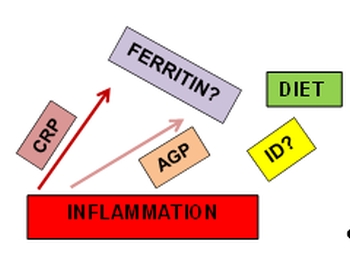An alternative approach to adjust the iron status for inflammation in population: an exploratory study
Abstract
Background: Iron deficiency (ID), one of the major micronutrient deficiencies globally, is challenging to measure. This is due to the dual character of ferritin which measures both the ID and concurrently affected by inflammation and infection. To address this, inflammation biomarkers—e.g., CRP (C-Reactive Protein) and AGP (Alpha-1- Acetylated Glycoprotein) are used through various standard methods to report inflammation-adjusted ID. However, there are problems with these methods and their underlying principles. An exploratory study was conducted to suggest an alternative way for inflammation adjustment with the focus on changing the inflammation-cut off point of the biomarker.
Methods: Data of the Bangladesh National Micronutrient Survey 2011-12 were used in three population groups—preschool age children (6-59 month), school age children (6-14 years) and non-pregnant non-lactating women of reproductive age. Spearman Rank correlation was used between the iron status markers (ferritin, hemoglobin) vs. the inflammation biomarkers (CRP; AGP) at various cut-off levels of the inflammation markers, e.g., all-values, ≤ 5 mg/L, ≤1 mg/L, and ≤0.35 mg/L. ID was estimated over specified ranges of percentiles of the inflammation biomarker.
Results: Spearman Rank correlation between CRP and ferritin showed statistically significant coefficients at various cut-offs of CRP, except at CRP≤1 mg/L in preschool children and at CRP≤0.35 mg/L in school age children. The decrease in ferritin concentration was 6.7%-11.1% across the studied populations between the inflammation-unadjusted concentration and at CRP≤1 mg/L. Generally, the prevalence of ID was higher at CRP≤1 mg/L than at CRP> 1 mg/L. These findings suggested that a single inflammation biomarker, CRP with a cut-off of >1 mg/L excluded the corresponding cases of inflammation-elevated ferritin, allowing for a simpler estimation of the inflammation-adjusted ID in this setting.
Conclusion: Usage of CRP with the cut-off ≤1 mg/L is a useful, simplified and economic way to report the inflammation-adjusted ferritin-based ID in Bangladesh and similar settings with a modest infection burden. The method needs assessment in areas where the infection-burden is higher or in settings where malaria is endemic.

Authors retain all copyrights. In making a submission to World Nutrition, they are certifying that all material is theirs except quotations, as indicated, and that they have obtained permission for any photos, tables, or graphics taken from other publications or websites.




